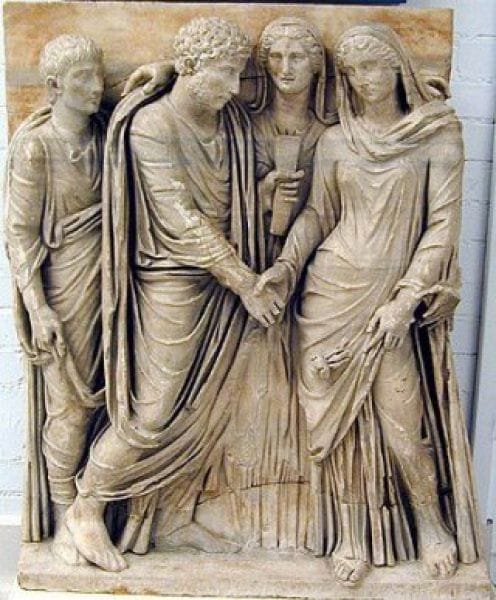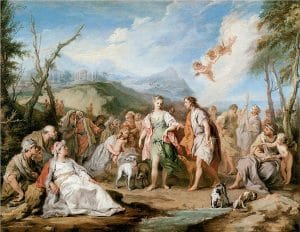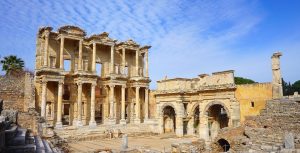Blog Titles
ToggleGet Married and Marriage in Ephesus
Get married in ancient Ephesus, marriage is an ancient Attic tradition. Marriage was a factor that emphasized social responsibility rather than personal relationships. In ancient Ephesus, marriage was a procreative and public benefit union. For marriages, usually, the request of parents, family elders, or matchmakers was used.
Laws and rules were established for marriages. For marriages to be valid, the man to be married must have the qualifications to support the household.

Or he must have come from a wealthy family, or a well-known and populous family or individual. Orphan girls were married to uncles or cousins from the family. Winter marriages were very important in ancient times for Hera, the goddess of marriage. Married couples would perform rituals such as covering their face, but the most important thing in marriage was being able to live together.
In ancient Ephesus, the most essential time for marriage was winter, and the most critical month was January. Because January was Gamelion, it meant Wedding-Moon. Marriages were made in the name of the goddess Hera. Meals were held in honor of the goddess Hera, and festivals were held.
In ancient Ephesus, marriages were arranged between Kyrios, meaning lord of the groom and bride. Kyrios explains that he allowed the girl he was his master to marry. Then for the girl to be married, the men who wanted to marry would compete with each other for the girl they preferred and to get married.
They brought extravagant gifts or competed with songs, dances, or games. When the groom was chosen for his daughter, the groom, and father would go through a process known as engysis, (‘pawning the hand‘), where the two men shake hands and say some ritual phrases.
The woman did not decide whom to marry only under very special conditions and did not take an active role in the engysis process, which was not unusual for that period. Before marriage, the groom and bride would make a binding promise that took place before marriage.
Marriage stages in Ephesus
In ancient Ephesus, marriage celebrations consisted of three different ceremonies: the pre-wedding ceremony we call Proaulia, the actual wedding we call Gamos, and the post-wedding ceremony we call Epaulia. Usually, weddings are focused on the bride. Weddings in Ancient Ephesus were usually held at night.
The first stage - Proaulia
Proaulia time is when the bride will spend her last days before marriage with her mother, female relatives, and friends as she prepares for her wedding day. It was a banquet held at the bride’s father’s house before Proaulia was married. In this ceremony, the bride would present various offerings called proteleia to gods such as Artemis, Athena, and Aphrodite.
“Toys were dedicated to Artemis before marriage by adolescent girls, as an introduction to finding a husband and having children. More important as a premarital rite of passage was the ritual of cutting and dedicating a lock of hair.
The sash, worn since adolescence, was presented to these goddesses.” These offerings and rituals symbolized the bride’s departure from childhood and her transition to adulthood, establishing a bond between the bride and the gods protecting the bride during this transition.
The second stage - Gamos
It was the wedding day when the ceremonies and rituals were held on the day the bride left her old house and settled in her new house where she will live with the groom. Sacrifices and offerings for the gods to bless two married people began with proteleia (premarital). The beginning of Gamos rituals of the day began with the wedding bath given to the bride. This bath was very special because it symbolized fertility and purification.
The water to be washed was placed in a special container called loutrophoros, and the bride was washed with the water in this container. After the bathing ritual was over, the bride and groom made offerings in the temple to ensure a healthy and fruitful life.
After the offerings to the gods, a wedding feast was held at the bride’s father’s house. Both the bride’s and groom’s families and relatives attended this feast. At this feast, men and women sat at separate tables. The women would sit and wait for the men to finish their meals. Then came the most important ritual of gamos, the opening of the bride’s veil. After the bride’s veil was opened, it meant that the bride had reunited with her husband, and Gamos ended with this ritual.
The bride was blessing the marriage by moving into the groom’s house. When the woman stepped into the house, sunoikein, ‘living together, legalized the engysis performed by the suitor and kyrios. It was very normal for the bride’s friends to visit the bride’s new home right after her marriage.

Although there is no clear explanation of the main reason for this, it is thought that it was done for the bride to adapt to the new life easily.

The most important part of the gamos was the wedding procession after the veil; A horse-drawn carriage driven by the groom was bringing the still-veiled bride to her new home, where she would live. Together with the bride and groom who came to his new home, he was visiting relatives who brought gifts to their homes.
The road to the bride’s new home was illuminated with torches on her way to her new home. The newlyweds were painted with pictures of the groom and the bride, and gifts were given to both the groom and the bride.
It is thought that the real purpose of these paintings was to alleviate the fear of newlywed brides that they would marry a man who is usually a stranger. When the bride and groom arrived home, they were greeted by their mother-in-law and brought directly to the hearth of the house. At this point, the couple was showered with dried fruit and nuts to bless them with abundance and prosperity. At this point, the groom would take the bride to the bridal chamber and ritually remove her veil.
Third stage - Epaulia
Epaulia was taking place the day after the gamos. This time is a process that happens when the bride and groom’s relatives receive gifts after they move to their new house and the bride starts to live in her new house. The gifts envisioned for the bride and groom were usually jewelry, clothing, perfume, utensils, and furniture.
Marriage life in Ephesus
According to archaeologists, divorce was not a shameful situation in ancient Ephesus. The issue of divorce could have been caused by scandal or negative behavior. Ancient Ephesus had the authority to initiate both husband and wife divorce. The husband had to send his wife back to her father to dissolve the marriage.
For the woman to divorce, she had to appear before the archon (Magistrate). Although divorces initiated by the woman were required to be registered with the archon, she did not seem to have any decision-making authority in this matter and only the woman’s request was recorded.
In the event of a divorce, the divorced woman would probably also need the support of her father and family. Situations stating that a woman’s dowry and financial situation would be returned in case of divorce were protected by law.

There were two other situations where a marriage could end between husbands and wives.
The first is the divorce initiated by the bride’s father; The extant example of this procedure is the “Speech of Demosthenes Against Spudias“. This was permissible only if the woman had not given birth to a child to her husband. Finally, if a woman became an epicleros after marriage (to be married to her uncle) after the death of her father, her closest male relative was expected to end both her and her current marriage to marry her.
If a woman was found to have committed adultery, the husband could divorce his wife, threatening to deprive the woman of her rights. However, in some cases, it has been seen that the husbands did not fully comply with this law because this bad situation was not heard about much or the scandalous event it could cause. Upon divorce, the wife’s husband was asked to repay her dowry. Otherwise, it was liable to pay 18% annual interest.
Marriage in the ancient world and in Ephesus was just like in our time. There were stages and families would be involved in the marriage ritual. Especially in Turkey and Anatolia, the same rituals continue depending on geography.
What is important is that the traditions of the past surprisingly continue today.
We apply everything in the ancient world today, perhaps slightly differently depending on our own culture. But what is important is the continuity of the ancient culture, and in our time, we continue our lives without adding anything to these traditions.
If we exclude time and technology, what is the difference between us and the people of ancient times, in short, our ancestors?





